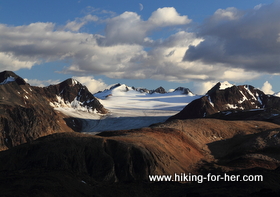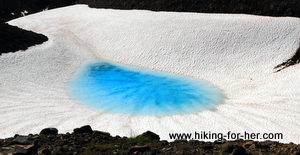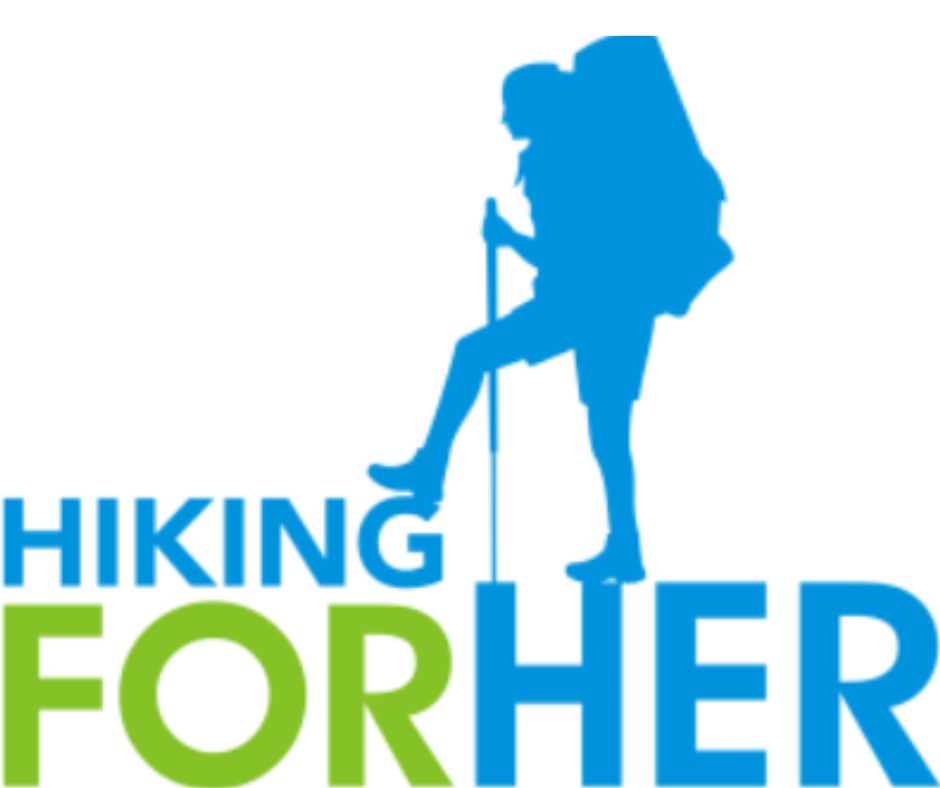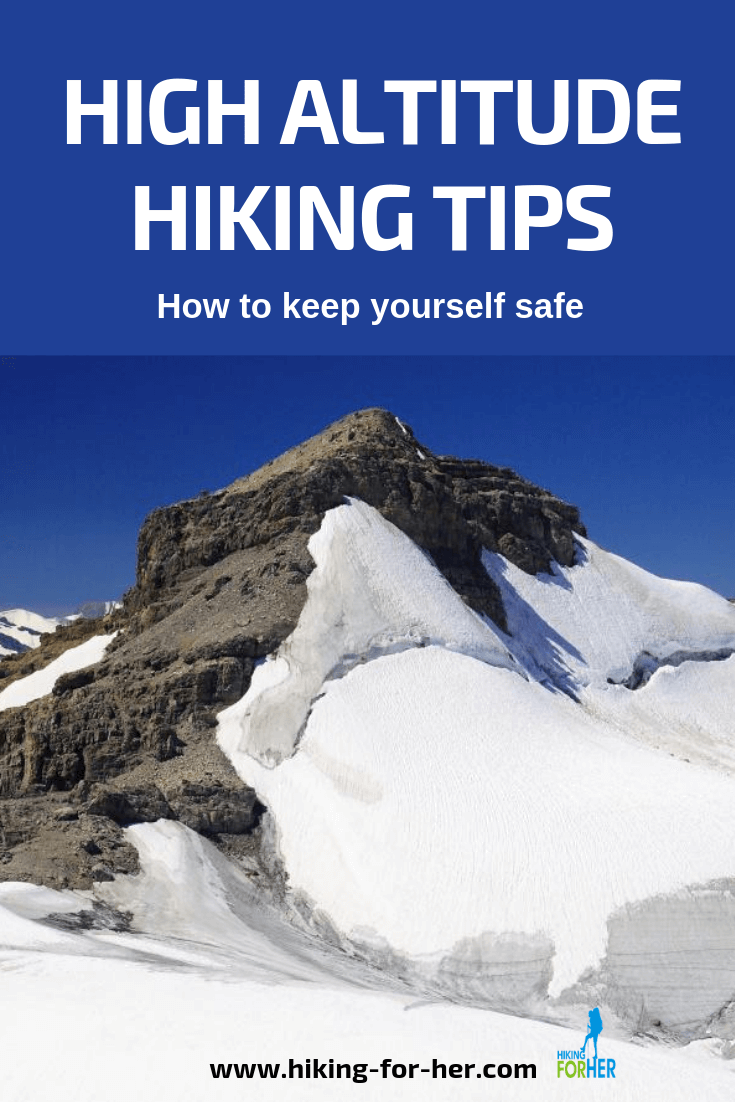Safe High Altitude Hiking:
Ways To Plan For It
By Diane Spicer
Safe high altitude hiking doesn't just happen.
It's a result of planning, conditioning, staying alert, and making smart decisions.
Let's take those one at a time, so you'll have a plan for how to prepare for a high altitude hike.
Note: For the sake of discussion, let's define a high altitude hike as anything over 7500 feet.
If you're coming from sea level, though, it could be as low as 6,000 feet.
Keep in mind that your individual physiology will dictate how well (or not) you handle elevation gain within a short period of time.
And here's more bad news:
Every hike at high altitude for you is different from the one before it.
- You can never predict exactly how your body is going to handle decreased oxygen levels (hypoxia).
Safe high altitude hiking:
how to plan for it
There are only 2 kinds of hikers in the world:
- Those who live at high elevation already, and those who don't.
I'm in the "don't" category, so when I go on hiking trips to areas where the trail head STARTS at 7,000 feet, I know I have to be smart about high altitude hiking.
Have a plan to keep yourself safe
Here is the plan I recommend to hikers who live at sea level, or at considerably lower elevations than the hikes they plan to tackle:
1. Choose your hiking itinerary carefully. Be moderate with your elevation goals and ramp up from there if all goes well the first few days.
2. Divide the number of days you plan to hike into three groups: easy acclimating walks, moderate elevation gain hikes, and, if you have enough time, hikes with several thousand feet of elevation gain and/or loss.
3. Be meticulous about knowing the elevation gain and loss of each hike you plan to do. And don't neglect to note the elevation at the trail head. Does it fit into your acclimation plans, or is it too aggressive?
4. Give yourself a day or two to acclimate to the trail head elevation by camping there, or staying somewhere nearby.
5. Don't deviate from your plan, just because you feel great. Things can change in a hurry (keep reading for details).
6. A rule that hikers use for sleeping at higher elevations is something along the lines of never sleeping higher than 1500 feet above where they began that morning.
- That doesn't mean you can't push higher once you set up base camp, just don't sleep any higher.
These rules respect the hard work your body is doing for you!
Safe hiking at high altitude:
conditioning
Whatcha gonna do if you live in Chicago, and plan to hike to the top of a 14'er? (14,000 foot mountain, such as the top of Mt. Rainier, or peaks in Colorado and New Mexico)
You're going to plan time to acclimate at the beginning of your trip, as noted above.
But what else can you do to prepare your body for the stress of decreased oxygen availability?
Plenty of ways to prepare for
high altitude hiking!
Here are a few ideas, none of which are medical advice:
- Increase your aerobic capacity slowly over several months of a steadily more vigorous training schedule. Pick the activities that you will enjoy, and go hard: swimming, biking, aerobic exercise classes, or running.
- If you already bike, find some hills. Particularly the uphill hills.
- If you're a long time swimmer, practice strokes that give you the option of holding your breath for several beats.
- If you run, head for the hills and work in some long staircases on your way there.
- When you go for daily training walks and longer weekly hikes (which you should be doing), wear your fully loaded pack.
Your goal
Your goal is to strengthen your heart, making it a more efficient pump to circulate your blood.
When you hike at higher altitudes, your lungs can't pull as much oxygen into your bloodstream so you need your heart to be able to distribute the less oxygenated blood efficiently.
Don't neglect the hard work of making your heart a better pump, and your lung capacity greater than it was at the beginning of your conditioning.
Your payoff: increased cardiovascular health.
It's one of the most important and far reaching benefits of hiking.
- Read about more than just physical fitness benefits here
Get checked out first
Because you are going to stress your body in order to condition it for more harsh conditions than you normally endure, a visit to your health care provider at the beginning of any vigorous conditioning regime is a great idea.
Include some blood work to uncover any potential issues with elevated cholesterol levels, vitamin deficiency, or electrolyte imbalances.
Staying alert to
warning signs
If you have zero experience with hiking at high elevations, you have no baseline on what to expect in high alpine conditions.
Be conservative on your first high altitude hiking trip, allowing your body to give you feedback about how it feels.
The higher you go, the higher the stakes if you keep going in the face of warning signs.
Warning signs to watch for on a high altitude hike:
- headache or dizziness
- lack of appetite
- absence of thirst even while sweating
- no energy
- nausea or queasiness
- clumsiness
Take action during high altitude hiking
From my own experience, you will begin to feel really weird, and you might have other people notice that you're acting weird, too.
At the first sign of trouble, turn around and descend slowly.
Don't talk yourself out of how you feel. Acknowledge that you're tanking, and turn around.
Although this should go without saying, I'm saying it anyway:
If you have a pre-existing medical condition involving your cardiovascular and/or respiratory system, you need to condition yourself to the fullest extent possible, and get a medical okay before tackling high altitude hiking.
 Prepare yourself so you can relax and enjoy the spectacular vistas of a high altitude hike
Prepare yourself so you can relax and enjoy the spectacular vistas of a high altitude hike
Altitude sickness
There are 3 ways in which your body could react to being placed at a higher elevation than it normally encounters.
Each of them carries serious consequences.
1. Acute Mountain Sickness (AMS): Acute means it comes on quickly, and can also be resolved quickly if you spot it and descend.
The warning signs mentioned above are associated with AMS.
2. High Altitude Pulmonary Edema (HAPE): The lungs fill with fluid (edema) and impair breathing to the point of coughing and chest pain.
This condition can quickly deteriorate into a life threatening situation.
That's why it's important to pay attention to small warning signs such as fatigue or shortness of breath that don't go away after resting or eating.
3. High Altitude Cerebral Edema (HACE): "Cerebral" means your brain has noticed that oxygen is in short supply, and the accumulating excess fluid is putting pressure on your precious soft brain tissue.
Unconsciousness can occur if HACE continues to build over hours or days.
For HAPE and HACE, immediate medical attention is required.
- Diamox (Acetazolamide) is a medication that can be purchased ahead of time and carried in your first aid kit. Read the directions carefully; you may have to start taking diamox a day or two before your hiking begins.
- Use your personal locator beacon or satellite messenger to summon help.
- If you can get down to lower elevation, do that immediately. Don't wait, because with each moment that goes by, more fluid is building and you're risking your health.
Make smart decisions
when hiking at high altitudes
Remove pride from your itinerary.
If you have to turn around without bagging a peak or snapping a photo from the viewpoint, so be it.
- Even if you're only a short distance from the top.
The scenery isn't going anywhere.
Next time you can prepare more thoroughly, or give yourself more acclimation time.
And sometimes you find out that your body just isn't cut out for high altitude hiking.
I have seen prime physical specimens twenty years younger than myself succumb to acute mountain sickness.
Other times, I've been the one to say "not one more step upward".
There is no shame in turning around.
And if you're hiking with someone who says otherwise, find yourself a different trail buddy. They don't have your best interests at heart (or in his/her brain).
Maximize your chances
of a successful high altitude outcome
To strengthen your chances of hiking safely at high altitudes, be sure you keep yourself well hydrated and snack frequently.
Shortness of breath can be compensated for with a slow but steady pace and deep even breathing, to a certain extent.
Pace yourself!
If you usually hike quickly, be smart enough to adopt a slower pace.
- Train yourself to kick into the mountain climber's pace of resting each non-weight bearing leg briefly as you climb upward.
- If this tortoise pace irritates you, you'll have plenty of time to ponder that personality trait :)
Keep track of your altitude gain, either by using an altimeter or by consulting your topographical map.
- For every 1000 feet of elevation gain, stop and rest.
Check in with yourself before moving upward.
Really listen to the little niggly doubts or hesitations.
- Eliminate possible explanations for your symptoms.
Example: Is your headache because you're squinting into the sun, or because you're dehydrated?
Are you exhausted because you started the hike with no breakfast, or because you need to eat more frequently in small amounts?
Is the pace too fast for the conditions, or merely too fast for you right now?
Or could you be experiencing the first symptom(s) of altitude sickness?
If you can't explain the way you're feeling with any other rational data, then face the facts: the altitude is messing with you and something(s) needs to change.
Minimize unnecessary risk taking
While hiking at high(er) altitudes, you encounter continuously changing terrain as you ascend.
Your 4 big concerns: rock, snow, ice and fickle weather conditions.
Monitor the weather
Pay attention to the cloud cover as the hours roll along.
Mountains create their own weather systems, and they don't give a lot of warning about changes.
So change your behavior when doing high altitude hiking.
Scan the sky for thickening clouds that are skudding along close to the ground.
Summer thunderstorms can roll in with unbelievable speed, and you're on exposed terrain. Know these lightning safety tips.
Be conservative in the face of atmospheric pressure changes that indicate a storm coming your way.
- An altimeter will help you with this, but also use your own inbuilt pressure gauge: your sinuses and ears.
Don't trust rocks
If you're on a route over rocks, be alert for instability as you take each step by placing your leading foot carefully before pushing off for the next step.
- Keep your weight on your back foot, use the toe of your boot to test the next rock, and be ready to correct your balance for wobbliness.
Watch and listen to the person in front of you; don't step where she did if she got a wobbler.
Don't ever rely on rock to stay put, even when they look solidly wedged underneath something.
- This applies to using them as handholds to scramble up or down, or for placing your full body weight on them while hiking.
If you're rock hopping across a talus field, be aware that there are holes between the rocks that you won't be able to see until you're right up to them.
- Slow down, stay alert, don't get distracted when placing your feet.
- Lash your trekking poles to your backpack to keep your hands free.
Rockfall from above is a hazard, especially in areas with mountain goats.
If you know that other humans are above you, communicate with them so they know you're there.
- Wait for them to move on before continuing your route.
- Extra insurance: wear a climbing helmet.
If you're in a group of hikers, keep plenty of distance between you to minimize the risk of being hit by a falling rock.
Navigating around or over snow and ice
Let's get the best tip front and center: the earlier you hit this type of terrain, the better.
- Sun is not your friend if you have to cross this type of terrain. You want your steps to meet frozen, solid ground.
- If you have to re-cross this area later in the day, factor that in to your risk assessment. Softer snow, exposed icy patches, steep slopes... worth taking a risk, or not?
If you have boot traction devices, put them on as soon as you hit the snow in anything other than soft snow conditions.
- Read more about hiking traction here.
If you're kicking up a lot of snow, wear knee length gaiters to keep your legs and feet dry.
The strongest hiker(s) should kick steps into steep snowy slopes or when crossing soft snowfields with risk of sliding onto rocks; this makes it easier for less experienced or smaller hikers.
If you're a newbie, trust the judgment of more experienced high altitude hikers.
If you don't have any of those handy, stay off angled snowfields or icy slopes.
It will be tempting to use a snowfield for an easier approach to a high point (plus there's less chance of rockfall above you) because you can move faster than across rocks.
But if you lack an ice axe, crampons and proper technique, turn around.
- The risk of sliding or encountering icy patches that will pitch you onto the ground is not worth gambling your personal safety.
Using snow bridges safely
The possibility of water flowing beneath snow and ice is high in alpine terrain, especially in the spring and summer.
The thickness and compactness of the snow is important to your safety.
When you see an obvious snow bridge across water, or hear water gurgling or rushing beneath your intended route, take precautions:
- Use a trekking pole to probe before you step. You want firm textures, not slushy or soft, before you move.
- If your feet are sinking in, retreat.
- If you posthole, get yourself back to more solid footing immediately. Don't press onward.
Everything looks good? Don't relax your vigilance.
Stay in the middle of the snow bridge as you cross.
Move slowly but deliberately, keeping your balance and putting even weight on your feet.
If it's a narrow bridge, hold both poles in your hands horizontally for balance.
Morning crossings are preferred, to capitalize on cooler night time temperatures. If you know you will be using the same route later in the day, scout for an alternative route before you go on.
Proactive protection against UV rays
The higher you hike, the more exposure to ultraviolet radiation you accumulate.
Your skin and eyes are not used to this amount of radiation, and a quick sunburn the outcome.
- Wear UPF sun protective clothing.
- Choose a high quality, breathable sun hat.
- Use high quality polarized sunglasses.
- Apply sunscreen and lip balm to protect exposed skin.
Crossing snow fields and glaciers
If your route takes you over snow and ice, be even more aggressive about sun protection by taking protective measures to safeguard your skin and eyes.
- Reapply your sunscreen every few hours, even if you're not sweating it off.
- Cover up all of the skin that you can. Hiking at high altitude in shorts and a tank top is asking for a burn, regardless of your baseline skin tone.
- Use eye drops to rehydrate your eyes, thus preventing corneal abrasions.
 This blue tarn is a pop of color in an otherwise black and white landscape. Keep your eyes safe so you can see it.
This blue tarn is a pop of color in an otherwise black and white landscape. Keep your eyes safe so you can see it.
As you climb higher,
the world changes
Here's a sobering fact about high altitude hiking: With every thousand feet of elevation gain, the air temperature drops by at least three degrees.
Be sure you've got enough clothing in your backpack to layer on.
You want to avoid getting chilled and adding to your altitude issues. You've chosen to ascend into winter conditions, so use these tips to guard your hands, feet and head:
You're working hard and may not notice that you need more layers, but your muscles will begin to complain.
Include a head and neck covering that can be lashed down tightly, in case the wind picks up.
- Because it usually does at higher altitudes, and radiating your body heat into space works against you up there.
Stay alert to hypothermia signs and symptoms, and take action immediately to reverse them.
- Fun (?) fact: you don't have to be wet, old or oblivious to succumb to hypothermia. It's a risk we all face at high altitudes.
Ear problems related to
high altitude hiking
As you climb higher, your ears and sinuses are tasked with equilibrating the pressure inside your head.
- Ever removed the lid from your water bottle and noticed the sucking sound of a pressure change? Imagine that happening inside your head.
Here's something to think about:
If you are actively battling an infection like a cold or middle ear infection, you're going to have a harder time adapting to altitude changes.
- This is especially true if you're taking a helicopter or plane ride from sea level to higher altitudes, with just a brief amount of time to cope with pressure changes.
Based on personal experience, you need to carefully consider whether your ear problems are going to hamper you on a high altitude hike.
- The pain of a double ear infection just might distract you from your hiking goals! (ask me how I know)
The pivotal factor is the amount of time spent at altitude.
- You might be able to get away with a day or two, but spending a week or more way up there might drive an infection deeper, or cause a chronic medical issue to act up.
Consult your health care professionals about how to handle your plans, and get their advice on medications or self care strategies you can use during your hiking trip.
Here's a link to get you started.
Know how to cope with
hiking related problems
Lots of things can happen to the human body on a hiking trail, and even more so at high altitude.
To be as prepared as you can be when you head up to the high zone, read up on how to cope with these issues as a hiker:
So is high altitude hiking
still appealing to you?
If you've read through this entire page, I'm guessing the answer is "Yes, I want to go for it!"
So take these four steps:
- Question, plan, condition, and go safely!
Some of the happiest hours of my life have been earned by slogging uphill to high elevations, such as Camp Muir on Mount Rainier (10,000 feet/3100 meters).
And some of my most miserable, queasy hikes have been at altitudes in Yellowstone that don't even come close to Camp Muir.
You just never know!
But now you know how to be smart about your plans for high altitude hiking.
Home page > Best Hiking Tips >
High Altitude Hiking
|
I get emails all the time about what I wear, eat, carry and love to use on the trail. That's
why I provide affiliate links to you: the best gear that I use myself and have seen used by other hikers is instantly
available for your consideration, and the gear company sends a few
pennies per dollar to this reader-supported hiking website. There is no added cost to you! Everyone ends up a winner: Great gear for you, strong gear companies, and more free hiking tips for everyone. Thanks very much for your support. It's warmly and sincerely appreciated. It also helps send these hiking tips to all your virtual trail buddies around the globe. |
 |



